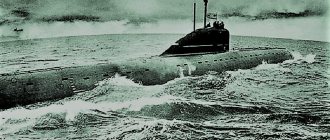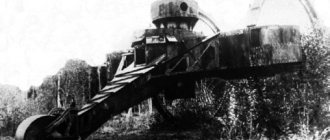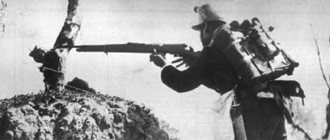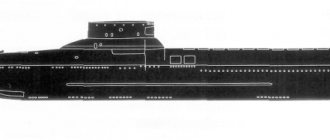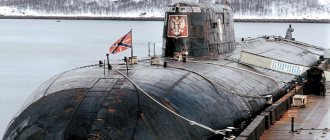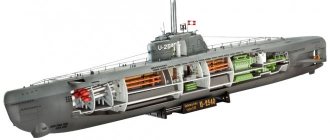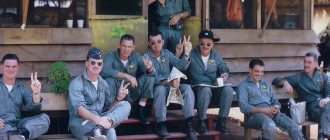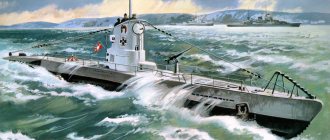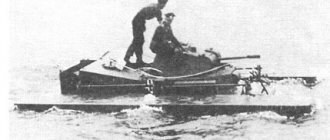On January 21, 1954, the nuclear submarine Nautilus was launched. She became the world's first submarine with a nuclear reactor. Five facts about the submarine, the creation of which opened a new page in the history of the Cold War, in our material
Nautilus was launched on January 21, 1954 in the presence of US President Dwight Eisenhower, eight months later the submarine was accepted into service with the US Navy, and on January 17, 1955, Nautilus began sea trials in the open ocean. 25 years later, the world's first nuclear submarine was withdrawn from the American fleet, and in 1985 it turned into a museum.
The name was “stolen” from Jules Verne
The submarine was named after the legendary ship of Captain Nemo from Jules Verne's novel Twenty Thousand Leagues Under the Sea. The fictional Nautilus had outstanding dimensions and technical characteristics for its time. Thus, Captain Nemo on his submarine covered a distance of 20 thousand leagues under water (approximately 90 thousand kilometers) in just seven months. Jules Verne's Nautilus could descend to a depth of 16 kilometers and accelerate underwater to 50 knots. In addition, the literary submarine could destroy surface ships using a special ram - a metal “tusk”, which was placed on the bow. However, according to another version, the world's first nuclear submarine was named not after the Nemov submarine, but after another American submarine, USS Nautilus (SS-168), which took part in the battles of World War II.
Time for the first ones. USSR nuclear submarines
Photo: Roman Abramov, wikimapia.org
On July 20, 1960 at 12:39, a radiogram “POLARIS - FROM OUT OF THE DEEP TO TARGET” was received from the US SSBN George Washington. PERFECT." The first launch of the Polaris ballistic missile was carried out from a standard carrier. The world had entered a new era, an era in which politics and power were determined not by dreadnoughts or aircraft carriers, but by underwater city killers. The American missile carrier carried 16 Polaris, capable of covering 2,200 km and delivering 600 kilotons with an accuracy of 1,800 meters. By the time the Cuban Missile Crisis began, the US Navy had nine such missile carriers.
The threat was serious, especially since we were lagging behind in terms of submarine missiles, and our R-13 with a surface launch could deliver a megaton charge only 600 km, but not so fatally - there were 22 diesel Golfs of the project in service during the Cuban Missile Crisis 629A, for a total of 66 P-13s, which, of course, is less than the US, but is quite enough to devastate the US coast. Moreover, to them should be added 6 Project 644 submarines carrying P-5 strategic cruise missiles, and six modernized Project 665 submarines with the same missiles. In total - 36 sea-based strategic cruise missiles. And this, again, is not all - the first six boats of Project 651 have already been laid down.
There was also a breakthrough in missiles - the R-21 missile with an underwater launch, a range of 1,400 km and a megaton charge was being finalized. It is clear that diesel missile carriers are not a panacea, but the United States had to take them into account, and the likelihood of turning its coastline on both oceans into a radioactive dead zone was quite real. In a word, there was no need for haste, especially since work was underway on even more powerful missiles and their launch vehicles, in no way inferior to the George Washingtons and Polaris. In the meantime, it was possible to engage in experiments and trial operation for several years.
It’s possible, but... The leadership of the USSR dreamed of the nuclear submarine, because here we were lagging behind. The first US nuclear submarine, the USS Nautilus, entered service in 1954, followed by the USS Seawolf with a liquid metal reactor in 1957 and the entire Skate series of four units in 1957-1959. In our country, the first nuclear submarine K-3 “Leninsky Komsomol” entered service only in December 1958. And immediately, without waiting for results and without trial operation, I went into production. And in parallel, again without further development, Project 658 missile carriers and Project 659 SSGNs, the first generation of Soviet nuclear submarines, went into production.
Our firstborn of Project 658 entered service on November 12, 1960, just a couple of months later than the American opponent, but they were completely different ships. Three R-13 missiles were incomparable with 16 Polaris, and a surface launch neutralized the advantages of a nuclear power plant - unmasking this way and that. And most importantly, the capricious and unreliable power plant gave the informal name K-19 - Hiroshima. We are talking about the events of July 3-4, 1961, when 8 crew members died as a result of a radiation accident. Repairing the boat took two years; the reactor compartment had to be completely replaced. The remaining 659 were also not happy: K-33 - two accidents with TVEL, K-16 - gas leakage in the circuit... And most importantly, the ships built with such difficulty and at such a price entered combat service only in 1964, and even then - in this During the same period, modernization began with their re-equipment with R-21 missiles. As a result, the eight missile carriers built brought minimal practical use, and after 1967, when the 667A SSBNs began to enter service, they instantly became hopelessly outdated. Although they were like this before, compared to their American opponents.
It is difficult to understand why they were built from a logical point of view - exactly the same functions with the same set of weapons were performed by the 629A diesel boats. And for training and testing technologies, torpedo nuclear submarines of Project 627 were quite suitable. For example, during the Cuban missile crisis, only one nuclear submarine of Project 659 was produced for combat, which, compared to 22 diesel ones, is a near-zero factor.
Even more incomprehensible is the history of the P-5 carriers - SSGNs of Project 659. They were built for the Pacific Fleet in the amount of five and in the end they received a carrier of 6 missiles with the same problems - surface launch, capricious power plant, high noise and low reliability. The result was, in general, similar: K-45 - primary circuit leak already during testing, K-122 - gas generator failure, K-151 - third circuit leak and overexposure of the crew. And most importantly, since 1964, the boats have been put in for repairs, the missile system has been dismantled, and turned into torpedo boats, some degraded analogues of Project 627. In a word, the money has been spent, unique specialists are busy, but there is no point. There was already something to study the operation of the reactor, but other diesel ships could also shoot the P-5. But the idea of a first-generation submarine with heavy surface-launched cruise missiles really resonated with the fleet leadership, otherwise it would be difficult to explain the slightly converted Project 675 submarines for the P-6 anti-ship missiles, built in the amount of 29 units. If at the time of design there were still chances for ascent, a 20-minute salvo and escort of missiles on the surface, then already in the 70s there were no chances. The submariners might have been able to fire the first four-missile salvo and escort the missiles until the homing target was captured, but at the cost of lives and the ship. The accident rate was also in complete order, although it was easier than in earlier projects - after all, the power plant had been more or less completed by that time.
Well, Novembers, as the Americans called them, Project 627A torpedo nuclear submarines. K-5 - replacement of the reactor compartment, K-8 - leak of a steam generator with overexposure of sailors, K-14 - replacement of the reactor compartment, K-52 - rupture of the primary circuit, overexposure of the crew... As a result, the boats were brought to life, spending a huge amount of effort and funds, the second generation began to enter service, turning the first-born into second-class ships. It’s clear that they were needed, it’s clear that this is a stage of development and testing, but why 14 ships for testing? It would be possible to start with experimental ones - one conventional, steam-water, and one with liquid metal, then, based on the test results, build a small series for testing basing and maintenance with crew training, and only then move on to the mass construction of the second generation. Instead, we built 56 ships of the first generation, after which we realized that we were still losing the race, and the basis of nuclear deterrence was still diesel missile carriers, and, finally, they began to build ships of the second generation, which by the end of the 60s ensured nuclear parity at sea and the threat of the US AUG - after all, the stealth SSGNs of Project 670, which began to enter the fleet in 1967, were much more dangerous for the enemy than Project 675, at least with lower noise, underwater launch of missiles and more advanced power plants. And it was they, nicknamed Charlie by the Americans, unlike ECHO 2, who could normally carry out an AUG attack.
In any case, monuments of that era still exist: in the form of the reactor compartments of first-generation boats sunk in the Arctic, with which they are now grimly considering what to do - raise them or leave them as they are. The first is expensive and very dangerous, the second is simply dangerous; they will not be able to stay safely at the bottom forever. We should not forget about the ruined destinies of people who served at that time and suffered huge doses of radiation. And if Khrushchev’s voluntarism had not manifested itself, it would have been possible to save fate, money, and the prestige of the country, which was not affected in the best way by regular accidents and catastrophes. Moreover, I repeat - there was no emergency need for the construction of 56 of these ships, and there was no emergency either; it was quite possible to get by with a much smaller number.
Russian roots of the creator of Nautilus
“The Father of the Nuclear Fleet” Hyman Rickover was born in 1900 in the town of Maków Mazowiecki, which was part of the Russian Empire before the October Revolution. The surname Rickover comes from the name of the village of Ryki, located near Warsaw. The creator of the world's first nuclear submarine came to the USA at the age of six; his family was forced to emigrate.
Nuclear Hiroshima discovered at the bottom of the Arctic
It would be a stretch to call the discovery of a container with a nuclear reactor of the K-19 submarine in Ambrosiev Bay in the Kara Sea a sensation. And the specialists of the “Tsentrospas” detachment of the Russian Ministry of Emergency Situations, who found this “object,” say that the search was planned, we are talking about sonar photography, subsequent visual inspection, spectral analysis, and sampling of plant material.
In this area, in the Novaya Zemlya depression alone, over the years, thousands of dangerous radioactive objects were buried after nuclear weapons tests, including the K-27 nuclear submarine resting at the bottom. Now we are talking about creating a register of underwater potentially dangerous objects sunk in the internal waters and territorial sea of Russia. Currently, this “black list” includes more than 24,000 individual objects - solid radioactive waste, chemicals and ammunition. There may be more of them - in Soviet times, Novaya Zemlya was a large testing site, and the “fragments” were sunk nearby, fortunately, the depth allows.
Huge mass
Due to the too high specific gravity of the nuclear installation, it was not possible to place some of the weapons and equipment provided for by the project on the submarine. The main reason for the weight was biological protection, which includes lead, steel and other materials - about 740 tons in total. As a result, Nautilus's entire armament consisted of six bow torpedo tubes with an ammunition load of 24 torpedoes, despite the fact that a larger number was assumed when designing the submarine.
The most famous Soviet submarine K-19 entered service 56 years ago
Soviet shipbuilders from the Central Design Bureau No. 18 (TsKB-18, the current Rubin Central Design Bureau) approached the creation of Project 658, having behind them, on the one hand, experience in building the first domestic nuclear submarines (NPS) of the Leninsky Komsomol type (project 627 and 627A, “Kit”), on the other hand, the first diesel-electric submarines with ballistic missiles on board.
The Project 658 boat was intended to carry out strikes with ballistic missiles with nuclear warheads on naval bases, ports, industrial and administrative centers located on the coast and deep in enemy territory.
close
100%
The chief designer of the project was the future academician and twice Hero of Socialist Labor, 37-year-old Sergei Kovalev, who in the late 1940s was part of a group of Soviet specialists who studied the achievements of German shipbuilders in Germany.
Work on the project began in August 1956, and already on November 12, 1960, the acceptance certificate for the lead submarine of the K-19 series was signed.
Quick solutions
The submarine of the 658th project was a double-hull type submarine (an external “strong” hull and an internal “light”), consisting of ten compartments. Hull length - 114 m, width - 9.2 m. Displacement - about 4030 tons.
The United States is looking for money for a “submarine of the 21st century”
A $101.3 million contract has been signed in the United States to create a new missile compartment for nuclear submarines of the...
02 November 23:59
Unlike the first Soviet nuclear submarines of Project 627, which had a rounded elliptical bow shape, Project 658 received pointed contours of the bow.
This decision was made to improve the seaworthiness of the K-19 on the surface. Initially, it was assumed that the launch of ballistic missiles would be carried out only on the surface.
The robust hull was divided by transverse bulkheads into ten compartments: 1st - torpedo, 2nd - battery, 3rd - central post, 4th - missile, 5th - diesel, 6th - reactor, 7th - turbine, 8th - electric motor, 9th - auxiliary mechanisms, 10th - stern.
As in the first Soviet nuclear submarines, the main power plant K-19 had a power of 35 thousand hp. and included two VM-A water-cooled reactors with a power of 70 mW with steam generators that rotated two propulsion units. In addition, the new submarine had two 450 hp “sneak” electric motors. each and two diesel generators.
With 80% of the power of both steam-producing installations of the ship in a submerged position, the maximum speed of the submarine was about 24 knots (44 km/h).
At this speed, the cruising range reached about 28 thousand miles (up to 50 thousand km). With a 100% load on the power unit, it was possible to reach a speed of about 26 knots (46 km/h). The submarine's autonomy was 50 days of continuous stay at sea without replenishing the ship's reserves of oil, fuel, provisions, fresh and distilled water.
The missile weapons consisted of three surface-launched R-13 ballistic missiles placed in vertical silos. The same liquid-propellant missiles, developed by special design bureau No. 385 (SKB-385) in Zlatoust, Chelyabinsk region, under the leadership of designer Viktor Makeev, were installed on the first Soviet submarine missile carriers - diesel-electric submarines of Project 629.
The limited width of the hull and the substantial dimensions of the 14-ton missiles and their launch devices made it possible to install missile silos in only one row.
Each of the three missiles was equipped with a one and a half ton nuclear warhead with a yield of 1 Mgt (about 50 times more powerful than the bombs dropped on Hiroshima and Nagasaki) and could deliver it at a distance of up to 600 km from the launch site with a deviation of up to 4 km.
In order to ensure fire safety, the rockets were stored filled only with an oxidizer - AK-27I (a solution of nitrogen tetroxide in concentrated nitric acid), and the TG-02 fuel itself was placed in a special container, outside the durable housing and separately for each rocket. It was applied to the product before launch. The launch of three missiles took 12 minutes after the boat surfaced.
“Putin’s most terrible missile”
Western tabloids were excited by the first image of a new Russian intercontinental ballistic missile...
26 October 21:25
The submarine's torpedo armament consisted of four bow 533-mm torpedo tubes (the ammunition load included 16 torpedoes) and two small-sized 400-mm stern tubes (6 torpedoes). The latter were intended for self-defense and firing anti-submarine torpedoes at a depth of up to 250 m; 533 mm torpedoes could be used at a depth of up to 100 m.
The need to surface to launch missiles and, therefore, automatically uncloak the submarine significantly reduced the combat stability of the missile carrier, so when modernizing the nuclear submarine under Project 658M, the installation of three SM-87-1 launchers and R-21 missiles with underwater launch was provided.
The R-21 single-stage liquid-fueled 20-ton missile could take off from under water and deliver a warhead to a range of 1,400 km with a deviation of 3 km.
Due to the conditions of the strength of the missiles and the accuracy of their impact, the launch could only be carried out in a narrow range of depths - the “launch corridor”. The R-21 missiles were launched from a depth of 40–60 m from the bottom of the missile at a boat speed of up to 2–4 knots (4–7 km/h) and sea state up to 5 points. The pre-launch preparation of the first rocket for launch took about 30 minutes. The firing time for three missiles is no more than 10 minutes.
At the same time, the impact of impulses arising during the launch of missiles led to the submarine’s ascent to 16 m, which did not allow it to be quickly brought to its original depth for the launch of the next missile. The complex of special means that keep the submarine in the required depth range is called the “possession system.”
Before the underwater launch of missiles, the K-19 silos were filled with water, and to eliminate the imbalance on the boat, special ballast tanks with a water pumping system were used.
After the missiles exited the silos, it was necessary to take about 15 cubic meters of water into the “equalization tank.”
The special navigation complex “Sigma-658” tracked the course, roll and pitch angles, calculated the speed of the boat and provided continuous calculation of current coordinates. During the pre-launch preparation of the rockets, this data was transmitted to computing devices, which took into account corrections for the rotation of the Earth and guided the rocket to a given target.
The first Soviet nuclear-powered rocket ships were built at a plant in Severodvinsk. The lead boat of the 658th project K-19 was laid down on October 17, 1958. She was launched on April 8, 1959, and entered service a year and a half later. In 1961, the Northern Fleet was replenished with the nuclear missile carrier K-33, in 1962 - K-55 and K-40, in 1963 - K-16 and K-145, and in 1964 - K-149 and K-176 .
Thus, over the course of six years, a program was implemented to build a series of eight nuclear submarines that carried a total of 24 ballistic missiles with nuclear warheads.
First and last K-19
The service of the first domestic nuclear-powered missile ship, the K-19, began at the end of 1960. In 1961, the submarine was fully practicing combat training tasks: it made three trips to sea, traveled 5,892 miles (11 thousand km) under water, and 529 miles (980 km) above water.
Submarines of all times and peoples
Military experts in the United States named the five best submarines in the entire history of armed confrontation at sea...
04 October 16:56
On July 3, 1961, at 4:00 a.m., the starboard reactor accident occurred on the nuclear-powered ship while submerged.
K-19 surfaced and continued to move while the main turbo-gear unit on the left side was operating. As a result of the depressurization of the reactor's primary circuit, a powerful radiation background arose in all compartments.
During the struggle for the life of the submarine, 30 people received heavy doses of radiation and died (15 in a few hours, nine in a few days, six within a year).
Approaching diesel-electric submarines and surface ships managed to evacuate the crew members and tow the submarine to Zapadnaya Litsa. In post-Soviet times, the incident became widely known, memoirs of the participants in the events were published, and in 2002 the feature film “K-19” was shot with Harrison Ford as the captain of the Soviet boat. In 2006, former USSR President Mikhail Gorbachev nominated the submarine's crew for the Nobel Peace Prize, insisting that the heroic actions of the crew saved the world from a terrible catastrophe and even possible nuclear war: if the dead sailors had not prevented the reactor explosion, the US might have accepted the incident for attempting to attack its naval base in the area.
After the accident, the boat received the ominous nickname “Hiroshima” from the sailors, but after repairs it continued to serve.
The problem of cracking of primary circuit tubes on nuclear submarines was solved by replacing stainless steel with titanium.
The K-19 was considered an unlucky ship by submariners. Accidents happened to her regularly. On November 15, 1969, the nuclear-powered submarine collided in the Barents Sea with the American nuclear submarine SSN-615 Gato, which was trying to covertly track a Soviet submarine. Both ships were damaged.
On February 24, 1972, when the boat was 1,300 km northeast of the island of Newfoundland, a fire broke out on board the Hiroshima, killing 28 crew members in the 5th, 8th and 9th compartments.
At the same time, the service of other submarines of the 658th project proceeded safely. K-115 in 1963 made the transition from the Northern Fleet to the Pacific Fleet, covering 1.6 thousand miles (3 thousand km) under ice in six days. In 1968, the under-ice crossing was repeated by the K-55, already with nuclear weapons on board.
Despite their high noise level and other disadvantages, Project 658M submarines remained in service in the 1970s, patrolling the ocean in close proximity to the American coast, and ensuring minimal flight time for their missiles. This made it difficult for the United States to take measures to counter a missile strike, but at the same time made the return of nuclear-powered ships to their native shores after completing the mission very problematic.
"Bulava" did not reach the target
On September 27, during a check of the fleet’s combat readiness, the nuclear submarine Yuri Dolgoruky fired two salvos...
28 September 18:12
The service of the last Project 658M nuclear submarines in the Northern Fleet continued until the end of the existence of the USSR. K-16, K-33, K-40 and K-149 were decommissioned in 1988–1990. They were in storage in Olenya Bay and Gremikha.
The last submarine of the K-19 series to lower the naval flag in 1991.
The first Soviet-made nuclear-powered missile ship, compared to a similar American ship of the George Washington class, had higher surface and underwater speeds, better combat survivability, and an increased diving depth, but was inferior to the “American” in terms of stealth and information technology characteristics. Project 658 was very significantly inferior to the US Navy ship in terms of the ship's tonnage to the mass of missile weapons. If on the George Washington for every ton of the Polaris A-1 missile there was a little more than 30 tons of submarine displacement, then on a Soviet-made boat this value increased to almost 130 tons.
Too much noise
One of the main shortcomings of the submarine was the terrible noise. The cause of its occurrence was strong vibrations of an unknown nature. The waves that Nautilus created caused vibration of the submarine's structures with a frequency of about 180 Hertz, which was dangerously close to the vibration values of the boat's hull. If these vibrations coincided, the submarine could collapse. During the tests, it was found that the noise, which was created already at a speed of eight knots, and vibration were an obstacle to the normal launch and control of torpedoes. At a speed of 15-17 knots, the crew of the submarine was forced to communicate by shouting. The high noise level made the sonar useless already at a speed of four knots.
Reached the North Pole
On August 3, 1958, Nautilus became the first ship to reach the North Pole under its own power. To conquer this geographical point, the submarine was equipped with special equipment that made it possible to determine the condition of the ice, and a new compass that operated at high latitudes. Just before the trip, William Anderson, who was at the head of the operation, obtained the latest maps and directions to the depths of the Arctic and even made an air flight that repeated the route planned for Nautilus.
On July 22, 1958, the submarine left Pearl Harbor with the goal of reaching the North Pole. On the night of July 27, the ship entered the Bering Sea, and two days later it was already on the outskirts of the Arctic Ocean in the Chukchi Sea. On August 1, the submarine sank under the Arctic pack ice and two days later Nautilus reached its goal - the Earth's North Geographic Pole.
First nuclear submarine
The biggest milestone in the 60-year history of the PGU-Ministry of Red Machinery-Minatom-Rosatom was the creation of a nuclear power plant (NPP) for the first nuclear submarine (NPS) in the USSR. The birth of the country's submarine and then surface nuclear fleets is largely due to her.
The idea of using unprecedented concentrations of nuclear energy not only for destructive purposes appeared among our scientists and engineers already during the creation of atomic weapons. Confirmation of the possibility of practical implementation of these ideas was facilitated by the development, construction and operation of the first industrial reactors and the world's first nuclear power plant. The plans to use nuclear energy sources in the fleet, primarily underwater, made it possible to solve the problem of creating an engine capable of providing the ship with fundamentally new qualities. Time has shown that, in combination with new types of weapons, nuclear energy has radically changed the strategic, tactical and technical capabilities of the submarine fleet and its role in the World Ocean, which has led to a significant adjustment in the military doctrines of leading countries.
As in the development of nuclear weapons, in the creation of the first nuclear submarine, our country had to catch up with the United States, which was ahead of the USSR in the construction and commissioning of its first nuclear submarine "Nautilus" by 4-5 years, to catch up independently, deciding, in the absence of analogues, many scientific and engineering problems in the new field of reactor engineering.
Formally, work on the creation of the first nuclear submarine began in the country with the issuance of Decree No. 4098-1616 of the USSR Council of Ministers on the design and construction of facility No. 627 on September 9, 1952. However, this decree was preceded by several years of development of various options for nuclear power plants for use at sea. They were initiated by our outstanding scientists and designers who worked on the implementation of the USSR Atomic Project. So, already in April 1946, i.e. six months after the formation of the PSU, it received a note from the President of the USSR Academy of Sciences S.I. Vavilov with proposals for the development of research on the use of nuclear energy in various fields of science and technology. The draft government resolution prepared by the Academy of Sciences and PSU is presented to S.I. Vavilov, I.V. Kurchatov, B.L. Vannikov and M.G. Pervukhin to the Special Committee under the Council of Ministers of the USSR. This project already provides for the development of “... ways to use nuclear reactions for power plants.” They are planned to be entrusted to the Institute of Chemical Physics and Laboratories No. 2 and No. 3 of the USSR Academy of Sciences with the involvement of the Central Committee for Technical Technologies and the VTI. On December 13, 1946, a corresponding order was issued by the Council of Ministers of the USSR.
More specifically, the issues of “...using the heat of nuclear reactions in power plants” were considered by the Scientific and Technical Council of PGU on March 24, 1947 with the participation of I.V. Kurchatova, N.N. Semenova, A.P. Zavenyagina, V.A. Malysheva and others. It was decided to begin research and design work on nuclear power plants in relation to ships, aircraft, and power plants. A certain role in the fact that ships were included in this list was played by reports that appeared in the foreign press about the beginning of such work on submarines and aircraft carriers in the United States.
And yet, the priority task of the Special Committee and the nuclear industry that began to be created until the end of the 1940s was the creation of nuclear weapons. Therefore, the development of power plants was carried out by small scientific and engineering groups. Some support for these works was the research plan approved by the USSR Council of Ministers for 1948, which provided for the development of preliminary design assignments for several types of relatively large thermal power (300-500 MW) enriched uranium reactors with various neutron moderators and coolants.
As for ship installations, on the initiative of I.V. Kurchatov NTS PSU in November 1949 considers and supports the considerations of S.M. Feinberg (LIP AS USSR) about the possibilities of creating “...a nuclear engine for ships (in relation to a submarine) in three versions (water, gas and metal cooling), engine power 10,000 kW at the shaft." In 1950-1951 at the Institute of Physical Problems of the USSR Academy of Sciences under the leadership of A.P. Aleksandrov is exploring the possibility of placing (primarily in terms of weight and size characteristics) on a submarine a nuclear double-circuit installation with a helium-cooled reactor with a thermal power of 40 MW with a graphite moderator. At NIIkhimmash - the developer of the country's first industrial reactors "A" and "AI" - under the leadership of N.A. Dollezhal are designing an installation based on the types of devices they have tested - channel devices with a water coolant and a graphite moderator with a thermal power of 150 MW (turbine power - 25 MW). Later, already in 1952, on the basis of these studies, together with the LIP of the USSR Academy of Sciences, a design specification was issued for a power plant powered by a propeller, with two reactors with a thermal power of 65 MW each. At the same time, at the LIP of the USSR Academy of Sciences in the sectors of S.M. Feinberg and V.I. Merkin is working on an installation with two pressurized water reactors of the same thermal power.
Intensive development of power plants for submarines was also carried out under the leadership of A.I. Leypunsky by a group of employees in Laboratory “B” together with designers from OKB “Gidropress” headed by B.M. Sholkovich. They developed the idea of using an intermediate neutron reactor with a lead-bismuth coolant, which made it possible to count on a sharp decrease in pressure in the primary circuit and high steam parameters in the second. These ideas were implemented in the nuclear power plant of the Project 645 nuclear submarine, built 5 years after the first nuclear submarine.
The other, led by D.I. Blokhintsev, a group of Laboratory B employees worked on a design for a water-cooled thermal neutron reactor, but with a beryllium moderator. It was subsequently used (under the index “BM”) along with the design of a pressurized water reactor (index “VM”) at the stages of preliminary design of the nuclear power plant of the first nuclear submarine.
Extensive search work on power plants made it possible to raise the question of starting the design of a nuclear submarine. In 1951 A.P. Alexandrov and N.A. Dollezhal send relevant proposals to the high command of the Navy, but do not find support. The situation can be changed with the help of V.A. Malysheva (Deputy Chairman of the USSR Council of Ministers, Minister of Shipbuilding Industry), and after another appeal from I.V. Kurchatova, A.P. Alexandrov and N.A. Dollezhal's letter to the government (1952) is prepared and signed by I.V. Stalin mentioned the Resolution of the Council of Ministers of the USSR. Its release intensified exploratory scientific and design work, defining their ultimate goal, and created the organizational foundations for the necessary cooperation of project participants both in the areas of their activities and in the timing of the work. It is characteristic that the PSU is not only responsible for resolving all issues related to the creation and testing of nuclear power plants, but also the general management of research and design work on object No. 627, i.e. first nuclear submarine. At the NTS PSU, a special section No. 8 was formed, headed by V.A. Malyshev. A.P. is appointed scientific supervisor of the work on “...implementation of object No. 627”. Alexandrov, his deputy for “...nuclear calculations and research” - D.I. Blokhintsev, chief designer of the “...integrated power plant” - N.A. Dollezhal, chief designer of object No. 627 - V.N. Peregudov. It is recognized as necessary “... to carry out design, experimental and research work on the creation of an integrated power plant for facility No. 627” to organize on the basis of the divisions of NIIkhimmash a special Scientific Research Institute No. 8 (NII-8), of which N.A. is appointed director. Dollezhal. A fundamental decision is made on the construction and testing of “...an experimental power unit” (i.e., a bench nuclear power plant) in Laboratory “B”.
One of the features of the government resolution was that it did not at all indicate the interests of the Navy and its participation in the work. This unusual situation persisted until the release of the technical design of the nuclear submarine, when, before its approval by the government, Navy specialists were involved in reviewing the project. According to their comments, the ship's design underwent significant adjustments.
The organization of design work at the first stages was also unconventional. On the one hand, the idea of creating nuclear submarines was put forward and persistently “pushed through” by reactor specialists, whose occupations were quite far from the problems of shipbuilding, and on the other hand, the creators of submarines actually began to become acquainted with the capabilities of nuclear reactors and the features of their use only after the government decree was issued , to which the development of nuclear submarines was entrusted to SKB-143 of the Ministry of Shipbuilding Industry. Therefore, under the leadership of V.N. Peregudov and F.F. Polushkina (head of the department of the Ministry of Shipbuilding Industry) a project group was formed (mainly from SKB-143 employees) to carry out initial studies on the boat. Most of this group worked at NIIkhimmash (NII-8 was located there for a long time) together with the designers of the reactor plant and employees of LIPAN USSR. In September-October 1952, based on an analysis of previously completed studies and the specified characteristics of the ship, V.N. Peregudov, N.A. Dollezhal and G.A. Gasanov (head of SKBK-189 - developer of steam generators) with the active participation of I.V. Kurchatov and A.P. Aleksandrov determined the basic initial data necessary for the design of a nuclear power plant - power, duration and operating modes, placement conditions on a submarine, weight and size restrictions, etc.
Already the first joint studies with the nuclear submarine designers showed the futility of using a uranium-graphite reactor on a boat due to its excessively large weight and size characteristics. Instead, at the suggestion of Laboratory “B” specialists, development of a variant of the installation with the already mentioned “BM” reactor began. Thus, the preliminary design of the nuclear power plant is presented with two reactor options - “VM” and “BM”. The designs of the nuclear power plant and the nuclear submarine itself were developed by employees of NII-8, LIP of the USSR Academy of Sciences, SKB-143 and SKBK-189 and released in January 1953 at NIIkhimmash. Immediately, the pre-draft design of the nuclear power plant in both versions was reviewed by section No. 8 of the NTS PGU, which approved the fundamental principles of the nuclear power plant and ordered the development of preliminary designs of the installation not only for the nuclear submarine, but also for the ground stand.
When carrying out pre-design studies, a number of major scientific and engineering problems emerged, without solving which the practical implementation of the idea of creating a reactor installation as the basis for the submarine’s power generation is impossible. Such problems in those years were, for example, the selection and justification of the neutronic and thermal characteristics of the first water-cooled reactor in our country, the development of methods and means of monitoring the processes occurring in it and in the installation, methods of controlling them, the formation taking into account the ship's specifics rational and effective radiation protection (its share in the total mass of the reactor plant reached 60-70%), organizing control over the radiation situation on the ship, ensuring comfortable working conditions for the crew, etc.
To solve these problems, under the leadership of A.P. Alexandrov and N.A. Large-scale research and development work was launched in Dollezhal. In their implementation, as well as in the development of nuclear power plant equipment and systems, scientific institutions of the USSR Academy of Sciences, institutes and design bureaus of various ministries and departments were involved (in addition to specialists from the LIP of the USSR Academy of Sciences and NII-8): Laboratory “V”, NII-9, SKBK- 189, Design Bureau of the Kirov Plant, TsNII-45, TsNII-48, VIAM, OKB-12, TsKB GM, PKB-12, Research Institute "Proektstalkonstruktsiya", FHI im. Karpova and others. In all “ship” issues, the SKB-143 employees provided great assistance to the nuclear power plant developers. While working on the project of a fundamentally new submarine ship (in the USA they adapted a conventional submarine for the Nautilus), they at the same time paid great attention to nuclear power plants and ensured the formulation and solution of many scientific and technical problems in the energy sector.
In July 1954, military sailors were first involved in the work on creating a nuclear submarine and its power plant. Review by Navy experts of the boat's technical design led to a revision of the ship's combat purpose and the composition of its weapons, but had virtually no effect on the designs of the nuclear power plant and its components.
In parallel with the development of the nuclear submarine and its power plant, a ground-based nuclear power plant stand is being designed (its index is 27VM), on which the reactor and turbine compartments of the boat with equipment and systems for installing the starboard side are reproduced. The objectives of the stand are to check the operability of the installation and its elements, ease of maintenance and repairs, living conditions in the power compartments, as well as training of nuclear submarine crews. In July 1955, the main construction work on the building and structures of the stand was completed, and the manufacture of the main equipment was completed. The manufacturer of turbine units for the stand, and then for the nuclear submarine, was the Kirov Plant, and most of the equipment for the stand and ship reactor plants - from the reactors themselves to large pipelines - was Plant No. 92. Their working drawings were developed by employees headed by I.I. Afrikantov of the factory OKB together with a large group of NII-8 designers seconded to the bureau in the summer of 1954, drawings of control rod mechanisms - with the group of S.M. Frankstein (OKB-12). Led the development of the working design from the plant's design bureau - Yu.N. Koshkin and from NII-8 - P.A. Delens. Technological development of the drawings was carried out by specialists from the relevant departments of the plant, after which they were immediately sent to the workshops. At the same time, the necessary stands and equipment for testing the equipment and its components were developed and manufactured.
Scientific director A.P. regularly visited the plant. Alexandrov and chief designer N.A. Dollezhal, which allowed designers and production workers to quickly resolve the most complex issues that arose. The progress of detailed design and manufacturing was controlled by senior officials of the Ministry of Medium Machine Building and the Ministry of Defense Industry, of which the plant was a part.
By March 1956, all the material part of the ground stand was mounted and prepared for action, and on March 8 at stand 27VM under the leadership of A.P. Aleksandrov, the physical start-up of the reactor was carried out. During the first period of operation of stand 27VM, physical studies of the reactor core were carried out, including at operating pressures and coolant temperatures, which confirmed the design neutronic characteristics of the zone and made it possible to begin work on their further improvement.
At this time, the construction of the submarine itself was already in full swing, the laying of which on the slipway of plant No. 402 in Severodvinsk took place on September 24, 1955. The pace of work on the construction of the nuclear submarine was practically not affected by very significant adjustments to its technical design and working documentation, made according to the comments of the Navy. SKB-143 specialists managed to carry out all the changes to the drawings during construction while preserving most of the existing groundwork. The construction process was complicated by something else: difficulties in supplying ship-specific equipment from numerous (about 80) factories, caused by a lack of experience in manufacturing new products for our industry with increased quality requirements, and the development of non-traditional structural materials and technologies. And for Plant No. 402 itself, the nuclear boat was the first, which manifested itself, for example, in the installation, welding and control of branched high-pressure pipelines in the reactor compartment that required special attention. In these circumstances, the experience of the Minsredmash organizations, which already had the construction of the ground stand 27VM, came in handy.
In August 1957, the first nuclear submarine was launched. Commissioning work began on it, which smoothly turned into mooring tests. On September 13-14 of the same year, nuclear fuel was loaded into the reactors, after which their physical starts were carried out. He supervised all operations of A.P. Alexandrov, and they were carried out by specialists from the IAE, NII-8, plants No. 402 and 92, and military acceptance officers. On April 19, 1958, after completing the installation of pipelines in the reactor compartment, checking the operation of the turbine with steam supply from another ship, completing all commissioning and testing operations, the officer-operators of the first crew of the nuclear submarine, under the control of IAE employees, brought the port side installation to power for the first time, and after month - and installation of the starboard side. This was followed by checks of the main parameters of the nuclear power plant, the radiation situation, etc. The positive results of these works made it possible to carry out comprehensive mooring tests of the power plant before June 5, 1958, under the leadership of an interdepartmental commission. Its power was limited to 60% of the nominal (at that time it did not rise higher at stand 27VM). The same restriction was in effect during the sea trials of nuclear submarines, which lasted until December 1, 1958. It should be especially noted that with the power of the nuclear power plant limited, the submarine reached a speed of 23.3 knots at a measured mile. In terms of rated power, the boat's speed would be 30.2 knots versus 27.2 knots guaranteed by the ship's specifications.
Sea trials were carried out by a government commission chaired by Deputy Commander-in-Chief of the Navy V.N. Ivanova. The scientific supervision of the tests was carried out by A.P. Alexandrov. To the energy section of the commission, headed by I.D. Dorofeev (Navy) included N.A. Dollezhal, V.N. Peregudov, G.A. Gasanov, P.A. Delens, N.M. Sinev, G.A. Gladkov, Yu.N. Koshkin and others. The final act of the commission, later approved by the Council of Ministers of the USSR, indicated that the nuclear submarine created in the USSR was the largest domestic scientific and engineering achievement in the field of underwater shipbuilding. The nuclear submarine was transferred to trial operation, and before it begins, work must be done to eliminate a number of shortcomings noted by the commission, incl. and in the power plant.
Trial operation of the first nuclear submarine (its tactical number is K-3) continued until the end of 1959. During this time, 3 trips to sea were made, the installation’s power rose to 80% of the nominal, various operating modes were tested and tested.
After completion of trial operation, the K-3 nuclear submarine began to be used both to carry out special command assignments and to serve in the vast oceans - a new type of combat activity for the Navy. In 1962, she made the first trip to the North Pole in the Russian submarine fleet, traveling 1,294 miles under the Arctic ice. In 1966-1967 – two autonomous campaigns with a total duration of 111 days, in 1973-1975. – three trips (total 149 days). In total, since the completion of nuclear power plant tests in 1958, the submarine has traveled 128,443 miles.
The first domestic nuclear submarine (from the end of 1962 it bore the name “Leninsky Komsomol”) served for almost 30 years before being withdrawn from the Navy.
It would be wrong to imagine the processes of creation and subsequent operation of it, and then the lead and serial nuclear submarines (a total of 55 nuclear submarines were built with nuclear power plants of this type) as a chain of continuous successes. Along this path there were many problems associated, first of all, with a fundamentally new energy sector, the accumulation of experience in operating nuclear submarines, and the formation of new industries - nuclear engineering and nuclear shipbuilding. Here are just two of these problems in the initial period of operation of nuclear submarines: the short duration of the campaign of the reactor cores and the low performance of steam generators due to the loss of tightness of their pipe surfaces. The severity of these problems was determined, in particular, by the fact that they directly affected the combat effectiveness of the nuclear submarine fleet. Therefore, the research, development and technological work begun by organizations of the Ministry of Medium Machine Building in cooperation with institutions of other departments during the design of nuclear power plants did not stop with the commissioning of the first nuclear submarine. They were developed with an increase in the depth of previously begun research, covering new directions. Thus, multifaceted work on physics, thermal hydraulics, strength, materials science, alloy metallurgy, etc., carried out at the Institute of Atomic Energy, NII-8, NII-9, VIAM, IPPE with the implementation of their results at leading enterprises in the industry - made it possible, on the basis of new scientific and technical decisions over several years to increase the duration of the active zone campaign by 6-7 times, bringing it to values acceptable for the fleet. The problem of steam generators was solved both by searching for methods and means of ensuring the quality of coolants washing their pipes (specialists from the Institute of Atomic Energy, the Karpov Physical Chemical Institute, NII-8 worked), and by finding corrosion-resistant materials, improved manufacturing technologies, bending, and welding of pipes (SKBK- 189, TsNII-48). The end result of this work was the introduction of steam generators with pipes made of titanium alloys, which eliminated this problem. The most important role in testing the solutions found for these and other problems was played by stand 27VM. Most of the innovations were tested there.
It is impossible not to note one more aspect of the work being carried out. They not only made it possible to solve the problems of improving power plants and ensuring the normal operation of existing nuclear submarines, but also outlined ways for the development of nuclear power plants for submarines of subsequent generations, and became starting points for the development and implementation of new creative ideas.
